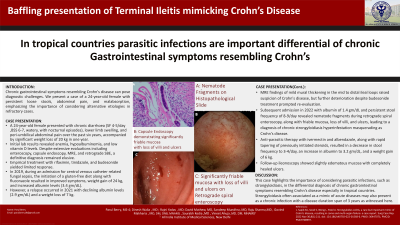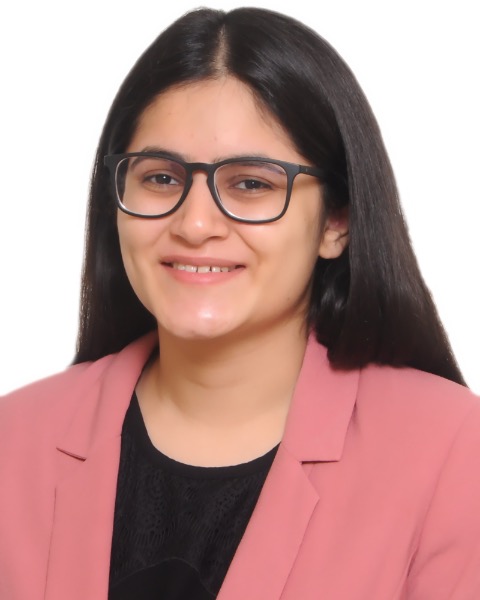Tuesday Poster Session
Category: IBD
P3676 - Baffling Presentation of Terminal Ileitis Mimicking Crohn’s Disease: Logic Defying Etiology
Tuesday, October 24, 2023
10:30 AM - 4:00 PM PT
Location: Exhibit Hall

Has Audio

Parul Berry, MBBS
All India Institute of Medical Sciences
New Delhi, Punjab, India
Presenting Author(s)
Parul Berry, MBBS1, Dinesh Walia, MD2, Rajni Yadav, MD3, David Mathew, MBBS, MD4, Sandeep Mundhra, MBBS, MD3, Raju Sharma, MBBS, MD4, Govind Makharia, MD, DM2, Saurabh Kedia, MBBS, MD, DM2, Vineet Ahuja, MBBS, MD, DM4
1All India Institute of Medical Sciences, New Delhi, Punjab, India; 2All India Institute of Medical Sciences, New Delhi, Delhi, India; 3AIIMS, Delhi, Delhi, India; 4All India Institute of Medical Sciences, Delhi, Delhi, India
Introduction: Chronic gastrointestinal symptoms resembling Crohn's disease can pose diagnostic challenges. We present a case of a 24-year-old female with persistent loose stools, abdominal pain, and malabsorption, emphasizing the importance of considering alternative etiologies in refractory cases.
Case Description/Methods: A 24-year-old female presented with chronic diarrhea (SF 4-5/day, BSS 6-7, watery, with nocturnal episodes), lower limb swelling, and peri-umbilical abdominal pain over the past six years, accompanied by significant weight loss of 20 kg in one year. Initial lab results revealed anemia, hypoalbuminemia, and low vitamin D levels. Despite extensive evaluations including enteroscopy, capsule endoscopy, MRE, and retrograde SBE, a definitive diagnosis remained elusive. Empirical treatment with rifaximin, tinidazole, and budesonide yielded a limited response. In 2019, during admission for central venous catheter-related fungal sepsis, the initiation of a gluten-free diet along with fluconazole resulted in improved symptoms, weight gain of 24 kg, and increased albumin levels (3.4 gm/dL). However, a relapse occurred in 2021 with declining albumin levels (2.9 gm/dL) and a weight loss of 7 kg. MRE findings of mild mural thickening in the mid to distal ileal loops raised suspicion of Crohn's disease, but further deterioration despite budesonide treatment prompted re-evaluation. Subsequent admission in 2022 with albumin of 1.4 gm/dL and persistent stool frequency of 8-9/day revealed nematode fragments during retrograde spiral enteroscopy, along with friable mucosa, loss of villi, and ulcers, leading to a diagnosis of chronic strongyloidiasis hyper infestation masquerading as Crohn's disease. Anti-parasitic therapy with ivermectin and albendazole, along with rapid tapering of previously initiated steroids, resulted in a decrease in stool frequency to 3-4/day, an increase in albumin to 3.2 gm/dL, and a weight gain of 6 kg. Follow-up ileonoscopy showed slightly edematous mucosa with completely healed ulcers.
Discussion: This case highlights the importance of considering parasitic infections, such as strongyloidiasis, in the differential diagnosis of chronic gastrointestinal symptoms resembling Crohn's disease, especially in tropical countries. Strongyloidiasis often associated as a mimic of acute diseases or as a superinfection may also present as a chronic infection with a disease duration span of 3 years as witnessed in this case.

Disclosures:
Parul Berry, MBBS1, Dinesh Walia, MD2, Rajni Yadav, MD3, David Mathew, MBBS, MD4, Sandeep Mundhra, MBBS, MD3, Raju Sharma, MBBS, MD4, Govind Makharia, MD, DM2, Saurabh Kedia, MBBS, MD, DM2, Vineet Ahuja, MBBS, MD, DM4. P3676 - Baffling Presentation of Terminal Ileitis Mimicking Crohn’s Disease: Logic Defying Etiology, ACG 2023 Annual Scientific Meeting Abstracts. Vancouver, BC, Canada: American College of Gastroenterology.
1All India Institute of Medical Sciences, New Delhi, Punjab, India; 2All India Institute of Medical Sciences, New Delhi, Delhi, India; 3AIIMS, Delhi, Delhi, India; 4All India Institute of Medical Sciences, Delhi, Delhi, India
Introduction: Chronic gastrointestinal symptoms resembling Crohn's disease can pose diagnostic challenges. We present a case of a 24-year-old female with persistent loose stools, abdominal pain, and malabsorption, emphasizing the importance of considering alternative etiologies in refractory cases.
Case Description/Methods: A 24-year-old female presented with chronic diarrhea (SF 4-5/day, BSS 6-7, watery, with nocturnal episodes), lower limb swelling, and peri-umbilical abdominal pain over the past six years, accompanied by significant weight loss of 20 kg in one year. Initial lab results revealed anemia, hypoalbuminemia, and low vitamin D levels. Despite extensive evaluations including enteroscopy, capsule endoscopy, MRE, and retrograde SBE, a definitive diagnosis remained elusive. Empirical treatment with rifaximin, tinidazole, and budesonide yielded a limited response. In 2019, during admission for central venous catheter-related fungal sepsis, the initiation of a gluten-free diet along with fluconazole resulted in improved symptoms, weight gain of 24 kg, and increased albumin levels (3.4 gm/dL). However, a relapse occurred in 2021 with declining albumin levels (2.9 gm/dL) and a weight loss of 7 kg. MRE findings of mild mural thickening in the mid to distal ileal loops raised suspicion of Crohn's disease, but further deterioration despite budesonide treatment prompted re-evaluation. Subsequent admission in 2022 with albumin of 1.4 gm/dL and persistent stool frequency of 8-9/day revealed nematode fragments during retrograde spiral enteroscopy, along with friable mucosa, loss of villi, and ulcers, leading to a diagnosis of chronic strongyloidiasis hyper infestation masquerading as Crohn's disease. Anti-parasitic therapy with ivermectin and albendazole, along with rapid tapering of previously initiated steroids, resulted in a decrease in stool frequency to 3-4/day, an increase in albumin to 3.2 gm/dL, and a weight gain of 6 kg. Follow-up ileonoscopy showed slightly edematous mucosa with completely healed ulcers.
Discussion: This case highlights the importance of considering parasitic infections, such as strongyloidiasis, in the differential diagnosis of chronic gastrointestinal symptoms resembling Crohn's disease, especially in tropical countries. Strongyloidiasis often associated as a mimic of acute diseases or as a superinfection may also present as a chronic infection with a disease duration span of 3 years as witnessed in this case.

Figure: A: Nematode fragments on HPE slide
B: Capsule Endoscopy demonstrating significantly friable mucosa with loss of villi and ulcers
C: Significantly friable mucosa with loss of villi and ulcers on retrograde spiral enteroscopy
B: Capsule Endoscopy demonstrating significantly friable mucosa with loss of villi and ulcers
C: Significantly friable mucosa with loss of villi and ulcers on retrograde spiral enteroscopy
Disclosures:
Parul Berry indicated no relevant financial relationships.
Dinesh Walia indicated no relevant financial relationships.
Rajni Yadav indicated no relevant financial relationships.
David Mathew indicated no relevant financial relationships.
Sandeep Mundhra indicated no relevant financial relationships.
Raju Sharma indicated no relevant financial relationships.
Govind Makharia indicated no relevant financial relationships.
Saurabh Kedia indicated no relevant financial relationships.
Vineet Ahuja indicated no relevant financial relationships.
Parul Berry, MBBS1, Dinesh Walia, MD2, Rajni Yadav, MD3, David Mathew, MBBS, MD4, Sandeep Mundhra, MBBS, MD3, Raju Sharma, MBBS, MD4, Govind Makharia, MD, DM2, Saurabh Kedia, MBBS, MD, DM2, Vineet Ahuja, MBBS, MD, DM4. P3676 - Baffling Presentation of Terminal Ileitis Mimicking Crohn’s Disease: Logic Defying Etiology, ACG 2023 Annual Scientific Meeting Abstracts. Vancouver, BC, Canada: American College of Gastroenterology.
